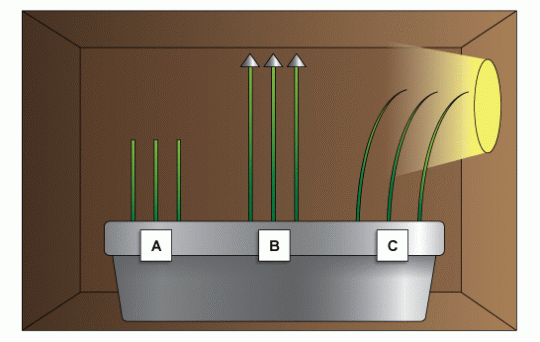Tagged: geotropism
Plant Tropisms: Grade 9 Understanding for IGCSE Biology 2.83 2.84 2.85
Plant Sensitivity
Sensitivity is a characteristic of all living organisms. It means the ability to detect and response to changes in the environment. When most students think of sensitivity they immediately think of receptors and the nervous system of mammals. In this post, I will summarise a few ways that plants are able to detect and respond to changes in their environment.
What stimuli are plants able to detect?
Stimulus Response
Light shoot grows towards light
Gravity root grows in the direction of gravity
Water roots will grow towards moisture
Touch some plants can grow towards touch
There are others such as day length, presence of certain chemicals and temperature too. But you can see that for all the stimuli in the table above, the response is by altering the pattern of growth. Animals often respond to stimuli with muscle contractions leading to movement. Plants have no equivalent of muscle tissue of course and so they respond through growth.
A tropism is a growth response in a plant in which the direction of the stimulus determines the direction of growth in the plant.
For example, positive phototropism would be the term used when a growing shoot will grow towards unidirectional sunlight. Growing roots will show negative phototropism when they grow away from light.
How is positive phototropism in a growing shoot brought about?
Plant growth is controlled by a family of chemicals called Plant Growth Substances (PGS) – in the past these were sometimes called plant hormones. The most important PGS and indeed the only one you need to know about for iGCSE is called Auxin. This chemical is made in the tip of the growing shoot and when it diffuses down a millimetre or two to the growing region, it can stimulate growth in two ways. Auxin causes cells in the shoot to divide by mitosis and also influences the cell wall of the plant cells allowing them to elongate. The net effect of this is to stimulate growth.
Auxin is actually a chemical called Indole Acetic Acid (IAA) and sometimes you will see it referred to by this name.
The detailed mechanism of positive phototropism in shoots is not well understood but we do know that if the shoot has brighter light on one side than the other, auxin will be moved towards the darker side of the shoot. This lateral redistribution of auxin allows the darker side to grow faster, so the shoot bends towards the light.
- Phototropism in plants is brought about by a chemical called AUXIN or IAA.
- Auxin is made in the tip of the growing shoot and diffuses down the stem towards a region of cell growth.
- If the shoot is growing in unidirectional light, the auxin will accumulate on the dark side of the shoot.
- Auxin stimulates mitosis in the growing region as well as causing individual cells to elongate.
- For this reason the darker side of the shoot will grow faster and so the shoot will bend towards the light.
Geotropism – a growth response to gravity
We know that the growing root and shoot are also able to detect gravity. A growing root will always grow downwards (positive geotropism) and the shoot upwards (negative geotropism). How are these responses brought about?
Well it’s our old friend auxin again…..
This diagram shows auxin moving downwards in a shoot under the influence of gravity. The lower side has a higher concentration of auxin and so grows faster. This results in negative geotropism in the shoot: it will grow in the opposite direction to gravity.
As far as I know, no-one really understands how the growing shoot and root are able to detect the direction of gravity. No-one really knows how the lateral redistribution of auxin due to light happens either…. There are still plenty of unknowns in this topic!
This final diagram shows positive geotropism in a growing root. It is positive geotropism because the root grows in the direction of gravity. If auxin accumulates on the lower side of the growing shoot and root (and it does) how does this work? Well it turns out that while auxin stimulates growth in the shoot, the same chemical inhibits growth in the root. So the diagrams above show auxin being produced at the tip (D) and accumulating on the lower side of the root (B). Auxin inhibits the growth of the root causing less growth on this side, so the root bends downwards.

Plant Tropisms – I can’t make myself do it….. 2.83 2.84 2.85
Is there a single topic more likely to strike fear into the heart of a GCSE Biology student? Everyone hates plant tropisms – students because it seems dull, and teachers because it seems like 19th century science and none of us can see for one second why it should appear in 21st century specifications….. I will write a post about auxins, phototropism and geotropism for your all but it will take me a day or two to build up to it….. As I said, everyone hates tropisms.




